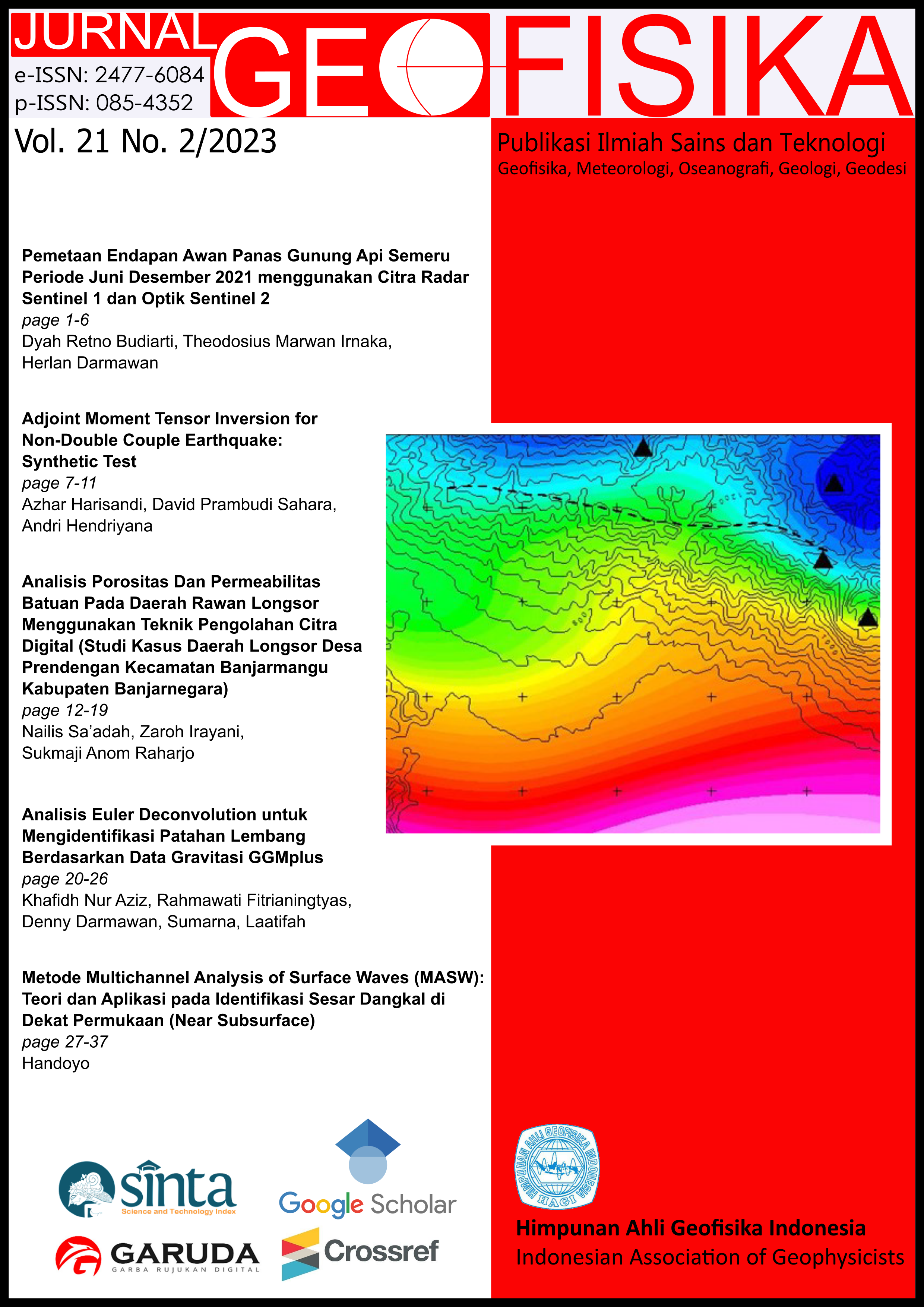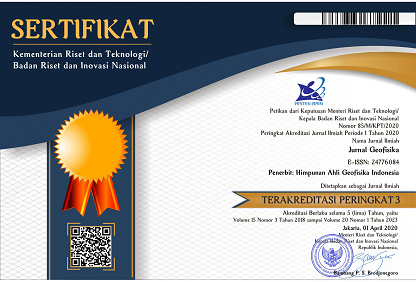Adjoint Moment Tensor Inversion for Non-Double-Couple Earthquake
SYNTHETIC TEST
Keywords
adjoint method, full-waveform, moment tensorAbstract
Adjoint method provides an elegant framework for computing the gradient of the misfit function with respect to model parameters. For the case of full-waveform adjoint moment tensor inversion, this can be achieved by recording the adjoint strain field in the source location. This adjoint strain is the product of adjoint simulation which can be achieved by solving the wave equation backwards in time from the receiver to the earth model and using waveform misfit as the adjoint source. In this paper, several test cases were defined to investigate the potential and stability of adjoint full-waveform inversion to invert moment tensor of non-DC earthquakes. The results from the test cases shows that misfit convergence to the reference model can be achieved if proper pre-processing step is applied to the waveform. Even for non-DC earthquake inversion that was using DC earthquake as a starting model. If this pre-processing step is not applied, this method can introduce a non-DC noise originating primarily from a non-accurate velocity structure and poor misfit convergence.
Keywords: adjoint method, full-waveform inversion, moment tensor
References
Ambara P., IP Raditya. 2020: Analisis Evolusi Struktur Vp, Vs, dan Vp/Vs melalui Tomografi 4D pada Lapangan Pertambangan Bawah Tanah “UC”, Tesis Program Magister, Institut Teknologi Bandung.
Bozdağ, E., Peter, D., Lefebvre, M., Komatitsch, D., Tromp, J., Hill, J., Podhorszki, N., Pugmire, D. 2016. Global Adjoint Tomography: First-generation model. Geophysical Journal International, 207(3), 1739-1766.
Chodacki, J. 2020: Simulation of ground motion in a polish coal mine using spectral-element method. Journal of Seismology, 24(2), 363–373.
Fichtner, A. 2010: Full Seismic Waveform Modelling and Inversion (Advances in Geophysical and Environmental Mechanics and Mathematics) (2011th ed.).
Gharti, H. N., Oye, V., Kühn, D., & Zhao, P. 2011: Simultaneous microearthquake location and moment‐tensor estimation using time‐reversal imaging. SEG Technical Program Expanded Abstracts 2011, 1632–1637.
Gharti, H.N., Oye, V., Roth, M., & Kuehn, D. 2017. Wave propagation modelling in various microearthquake environments using a spectral-element method. arXiv: Geophysics.
Kawakatsu, H., & Montagner, J. P. 2008: Time-reversal seismic-source imaging and moment-tensor inversion. Geophysical Journal International, 175(2), 686–688.
Kim, Y., Liu, Q., & Tromp, J. 2011: Adjoint centroid-moment tensor inversions. Geophysical Journal International, 186(1), 264–278.
Komatitsch, D., Tromp, J., & Vilotte, J. 1998. The spectral element method for elastic wave equations: Application to 2D and 3D seismic problems. SEG Technical Program Expanded Abstracts 1998.
Komatitsch, D., & Tromp, J. 1999: Introduction to the spectral element method for three-dimensional seismic wave propagation. Geophysical Journal International, 139(3), 806–822.
Komatitsch, D. 2004. Simulations of ground motion in the Los Angeles Basin based upon the spectral-element method. Bulletin of the Seismological Society of America, 94(1), 187-206.
Liu, Q. 2004: Spectral-Element Moment Tensor Inversions for Earthquakes in Southern California. Bulletin of the Seismological Society of America, 94(5), 1748–1761.
Liu, Q., & Tromp, J. 2006. Finite-frequency kernels based on adjoint methods. Bulletin of the Seismological Society of America, 96(6), 2383-2397. doi:10.1785/0120060041
Modrak, R., & Tromp, J. 2016: Seismic waveform inversion best practices: regional, global and exploration test cases. Geophysical Journal International, 206(3), 1864–1889.
Schewchuk, J. R. 1994. An introduction to the conjugate gradient method without the agonizing pain. Pittsburgh: Carnegie-Mellon University. Department of Computer Science.
Tape, C., Liu, Q., Maggi, A., & Tromp, J. 2010: Seismic tomography of the southern California crust based on spectral-element and adjoint methods. Geophysical Journal International, 180(1), 433–462.
Tape, C., Liu, Q. and Tromp, J. 2007, Finite-frequency tomography using adjoint methods—Methodology and examples using membrane surface waves. Geophysical Journal International, 168: 1105-1129.
Tromp, J., Tape, C., & Liu, Q. 2004: Seismic tomography, adjoint methods, time reversal and banana-doughnut kernels. Geophysical Journal International, 160(1), 195–216.
Wang, Y., Shang, X., Wang, Z., & Gao, R. 2020. High-accuracy location of microseismic events in a strong inhomogeneous mining environment by optimized global full waveform inversion. Applied Sciences, 10(20), 7205.

This work is licensed under a Creative Commons Attribution 4.0 International License.
The copyright of all articles belongs to the authors. All other copyrights is held by the Journal











